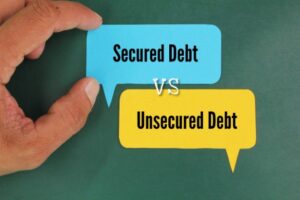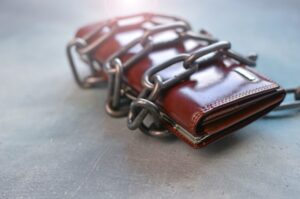
A mortgage and a credit card bill may both be debt, but there is a fundamental difference between them. One is secured and the other is unsecured debt. It’s important to know the difference because it has a major impact on the risk level and costs.
In a nutshell, when someone borrows money and offers something valuable, called collateral, as a guarantee, that is secured debt. However, when someone borrows money without offering anything in return, that is unsecured debt.
Unsecured debt examples
Credit cards are a good example of unsecured debt. You do not offer anything as collateral, and the lender trusts that you will pay them back. If you don’t, interest is added to your account. High interest rates mean you could quickly end up with credit card debt that is hard to pay off.
Other examples of unsecured loans include personal loans, private student loans, and payday loans. These do not use collateral, so lenders usually charge higher interest rates to make up for the risk.
Some people also use an unsecured line of credit, which lets them borrow up to a preset limit without offering collateral and at low interest rates. They can use any amount of the funds they need, up to the limit.
Secured debt examples
If someone wants to buy a car, they might take out an auto loan or a car loan. In this case, the car itself is used as collateral. This is a secured debt. If the person does not make the monthly payments, the lender can take the car back.
Another common secured debt is a mortgage, where a house is the collateral. Or someone might use a home equity loan, which means they borrow money based on the value of their home.
Some people have a secured credit card. This means they put down a deposit with the company. The deposit, essentially, becomes collateral. If they do not pay the bill, the bank keeps the deposit. Secured credit cards are great for helping someone build a credit history if they are just starting out.
Who to trust?
Banks do not know everyone personally, so how do they decide who they can trust with borrowed money? They refer to credit reports.
A credit report is a summary of someone’s borrowing history with a calculated credit score. The credit score is an indicator of how well someone has handled money before. If a person pays their bills on time and does not borrow too much, they usually have a high credit score. So the banks would know this person is reliable.
Banks also look at a person’s credit history, which shows how long they have used credit, how many loans or credit cards they currently have, and if they make monthly payments on time. Banks also check how much debt someone already has and what kind of loans they have used in the past years.
All of this information helps banks and lenders decide whether to lend money to someone and, if so, at what cost.
Non-payment consequences
The consequences of not paying back a secured loan are pretty straightforward: the lender takes back the collateral. When it comes to unsecured debt, things aren’t as cut and dry.
There’s a cost to having unsecured debt. Lenders are taking a bigger risk with unsecured debt. That increase in risk means they often charge very high interest rates. These high rates mean interest costs can add up and quickly get out of hand if not paid off in a timely fashion. Without any collateral to collect, lenders will either take the borrower to court or sell the debt to a debt collector. The debt collector will then pursue the borrower for repayment.
That said, Canadian laws include a “limitation period”. That means after a certain number of years, the lender loses the right to take legal action to collect the debt. They can still contact you to request that the money be repaid, but they cannot take you to court. The rules around limitation periods vary from province to province, so it’s important that borrowers understand what they are in their area.
Getting help with debts
Feeling unsure about how to handle your debts? Simple takeaways are: borrow only what you need, keep your credit card balance below 30% of your credit limit, and always try to make monthly payments on time. This can help you build a good credit score and make borrowing easier in the future. Luckily, when debt becomes unmanageable, there are ways to get it back under control. Below are a few:
Credit counselling – A credit counsellor will negotiate with the borrower’s creditors to lower the interest, often to 0%. The borrower will still be responsible for paying back the lender, but each payment will have a much greater impact on lowering the original balance instead of the interest.
Debt consolidation – Debt consolidation combines multiple debts into one, often at a lower interest rate. This makes monthly payments easier and lowers interest costs.
Licensed Insolvency Trustee (LIT) – These are federally regulated experts who can help coordinate Consumer Proposals and Bankruptcies. While these options have a significant impact on the borrower’s credit, they give them the chance to regain their financial footing.
While all these debt solutions are available, not all of them will necessarily be suitable for a particular borrower’s circumstances. For example, typically, unsecured debt can be eliminated through bankruptcy, but secured debt cannot.
Wrap-up
The main difference between secured and unsecured debt is collateral. Collateral is essentially the lender’s backup plan if borrowers don’t pay. Unsecured debt doesn’t include a built-in backup plan, so it often costs a lot more.
Learning how debt works can help you make smart choices with money, now and in the future. If debt becomes too hard to manage, there are ways to get help. One option is to contact one of our trained Credit Counsellors for a free consultation. They’ll discuss your particular financial situation with you and make a recommendation as to what debt relief option is best for you.






